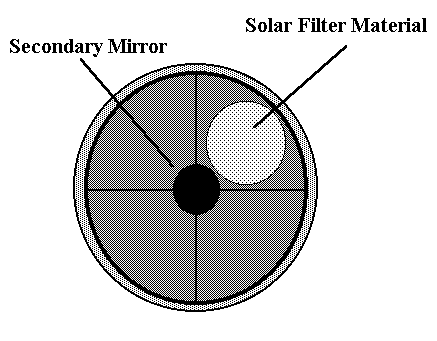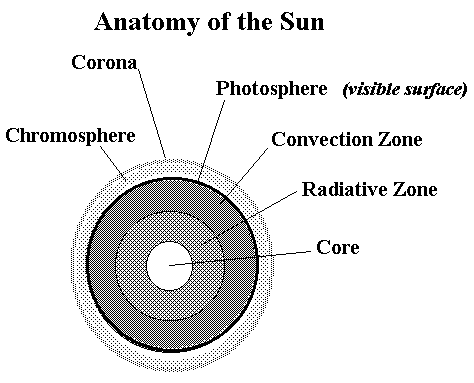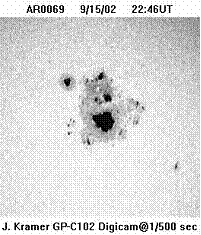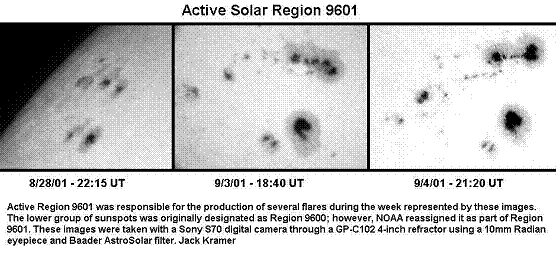You Can Observe the Sun
Jack Kramer
Is it safe to observe the Sun? The answer is "yes" and "no". Unlike other forms of observing, there is always a real danger. Observing the Sun requires the right equipment and some attention to detail, otherwise you can do serious damage to your eyesight. But if done right, it can be a worthwhile pursuit.
So how do you do it safely? Let's begin by saying what you shouldn't do. Obviously, never look at the Sun without an appropriate filter - up in the sky or through a telescope. An unfiltered glance through a telescope would cause instantaneous and permanent blindness in that eye. The second worse thing you can do is to look through a scope with one of those "solar filters" that screws into the eyepiece. The heat buildup from the image focused by the primary lens or mirror is sufficient to crack these filters, leaving your eye exposed to the blinding rays of the Sun. Thankfully, most telescopes don't come with these kinds of filters anymore.
One method that has been around a long time is solar projection. Here the image of the Sun is projected through the telescope onto a white card or other screen. The sunspots and faculae show up well, and it's a convenient way for a number of people to observe at the same time. But while this method is fairly safe, it can also be detrimental to your telescope. The focused rays of the Sun build up such an intense amount of heat that your eyepiece may become too hot to touch. As a result, bubbles may form between the cemented lenses or a lens may crack. I used to have an inexpensive throw-away eyepiece that I reserved just for solar projection. The secondary mirror or diagonal won't get quite as hot, but I've heard it said that even this amount of heat could cause a premature breakdown of the coating.
An unfiltered solar image passes through the optical systems at many professional observatories. An example is the solar tower telescope at Sacramento Peak in New Mexico. But in most cases, the telescopes are of a special design - the tube is vacuum sealed and the optics are temperature-controlled.
Solar projection fell out of favor when effective filters became available to cover the entire optical system. Here a filter is mounted in front of the primary mirror or lens so that only about 1/1000 of 1% of the Sun's light enters any part of the telescope.
There are different types of filter material - glass and coated thin film (note that this is not a photographic type film). Both are equally effective in filtering the Sun's light, and both require reasonable care in handling, as with any optic. Mylar and other thin film materials are susceptible to scratches and pinhole punctures, but glass also can be scratched and/or broken. The glass gives a natural yellow color to the image, while the film's image is generally light blue. The film should not be drawn tightly (which distorts the image), so it's wrinkled when mounted in a cell. The filter suppliers say that this in no way affects the optical qualities. I've had both glass and Mylar filters, and despite the conflicting claims of the various suppliers, I haven't been able to detect much difference in image quality between the two. The background tends to be lighter with the Mylar filter, so bright spots, such as faculae, seem to be more obvious. A more recent product is the Baader Astro Solar film, which gives a noticeably sharper image than either glass or Mylar filters. I now use the Baader filter exclusively for white light solar observing.
The costs of the mounted filters are about the same, but if you buy the material and make your own cell, film is less expensive. Note that this is precision-coated film, not the silvery gift wrapping material sold in party goods stores, which is very unevenly coated and full of minute pin-sized irregularities. That's an important difference!
Because the Sun's image is so bright, you don't need much light gathering, thus a small telescope with good optics will do just fine. The only advantage of using a larger telescope would be the superior resolution. In larger Newtonian and Schmidt-Cassegrain telescopes the filter is usually mounted in an off-axis diaphragm which bypasses the secondary mirror obstruction. In effect, this is cutting down the size of the optics in favor of a somewhat higher contrast image. It's also less expensive because you can get away with a smaller filter.

Off-Axis Diaphragm
Another consideration is that if you have a telescope with an open tube (i.e.: a truss-type tube), then you'll have to use a dark shroud to cut out stray light. The "inside" of the tube must remain dark, otherwise, scattered light makes it virtually impossible to see the Sun's image.
A few more precautions are in order:
- Make sure the finder scope is completely covered. Someone may inadvertently look through a finder...and be blinded. Moreover, all that solar heat isn't doing your finder any good either! However, a finder covered with lens caps still serves as an effective pointing device. If you aim the telescope so that the shadow of the finder projected on your hand or the ground shows a perfectly circular silhouette of the finder scope, then the Sun's image is likely to be in the main telescope's field of view.
- Always make sure the solar filter is firmly affixed to the end of the telescope tube. You don't want it to fall off with a sudden gust of wind or if the telescope is accidentally jarred.
- Always stay with your telescope at a public event to make sure that no one decides to play with it themselves and ends up getting blinded. If you must leave the telescope, cover it and point it away from the Sun.
- 4. Even when you're observing by yourself or with other amateur astronomers, never leave the scope pointed at the Sun without a filter in place. Someone may come up to take a look, without realizing the filter's not attached. Also, some telescopes have been damaged or actually caught on fire because the solar image drifted out of line with the focusing mount, then onto a wooden or plastic component. I even read where someone burned the roof liner of his car because sunlight landed on the mirror of his open-tube telescope laying on the back seat and was refocused onto the ceiling of the car!
With the necessary precautions, you might wonder whether observing the Sun is worth all the fuss. Well, consider that this is the nearest star, and that by studying the Sun, we can surmise that it shares a lot of features with other stars that we see in the night sky. Add to this the fact that the features are constantly changing - reshaping, growing or shrinking - and moving across the face of the solar disk. During the minimum of the eleven-year solar cycle there are times when there's absolutely nothing to see on the face of the Sun. But when we're near the peak, that's when sunspots and other activity become abundant. The peak of the next solar cycle (number 24) should be in 2013.
There are a variety of things you can see on the photosphere (the visible surface of the Sun). Sometimes features can also be detected in the chromosphere -- a transparent layer of gas that rises about 6000 miles above the surface. The corona is a large, tenuous, and hot region (2.5 million kelvins!) that lies above the chromosphere, but it's only visible during a total eclipse.

Sunspots are the most obvious objects on the Sun. They're cooler areas that are really bright but appear darker than the adjoining surface, which is still hotter. Sunspots average about 8,000o, while the visible surface of the Sun is about 11,000o. A distortion of the Sun's magnetic field lines allows an upwelling of this cooler material to the surface. The larger sunspots are many times the diameter of the Earth. The darker center of a sunspot is referred to as the umbra, while the lighter (and somewhat hotter) edge is the penumbra. Sunspots may last as long as several weeks, and they often change shape over this period. Especially during peak periods, sunspots appear in groups, referred to as active regions, which are numbered, as in the following image.

Faculae are small hot areas brought to the surface from the convective zone just below the photosphere. They normally reach a maximum size of about 600 miles and appear as lighter granules covering the surface. They are more visible near the limb of the Sun. Spicules appear to be the same, but are hot areas in the chromosphere. If you observe over a period of an hour or more, you may be able to detect changes in these phenomena.
Although there is an interest in sunspot numbers, information on the changing shape of sunspots is often more in demand scientifically than just the number of spots visible. In the following image it becomes obvious how active sunspot regions change shape as they move across the sun.

Up to this point, we've been concerned with "white light solar observing" - using a filter that simply attenuates the brightness so we can safely observe the sun. Many amateur astronomers also use special filters in order to see details that are only visible in the extremely narrow bandwidth of hydrogen-alpha (ha) light. This sometimes requires a telescope dedicated to solar observing. The Coronado Instruments PST is one of the most popular of those telescopes and is a good first step for someone interested in observing a wider range of solar activity. The following are examples of objects visible in the ha light band.
Prominences are huge outpourings of hot gasses that are caused by magnetic field disturbances generally associated with sunspots. The most dramatic ones take the form of gigantic loops that arch over the limb of the Sun.
Flares are similar to prominences in that they are associated with magnetic disturbances and sunspots, but they're flashes of light on the surface of the Sun. These flashes are up to ten times brighter than the average surface and expel vast amounts of charged particles that travel away from the Sun at speeds up to 2.7 million mph! It is these flares which produce dramatic auroras (northern lights). Once in a great while, they're bright enough to be spotted in a telescope using a white light filter - they would appear as bright lines or patches near or crossing a large sunspot. More commonly they're seen only in ha light. Plages are emission areas in the vicinity of active regions, and usually also appear as brighter spots.
Some challenging activities involve careful estimating and calculating. Knowing that the diameter of the Sun is 865,000 miles, you can estimate the sizes of sunspots and determine whether they're growing or shrinking. You can also check the rotation rates at different parts of the Sun's surface by watching a sunspot over several days. (One rotation takes about 27 days at the equator and 34 days at the pole.) Here's where an eyepiece with a graduated scale reticle comes in handy. Begin your observation with a low power eyepiece that provides a view of the entire solar disk. This let's you locate any prominent sunspot groups and provides a frame of reference for determining sizes and positions on the surface.
If you get really caught up in solar observing, you might want to submit observations to the Solar Division of the AAVSO (American Association of Variable Star Observers). For more information on the Solar Committee contact Chairperson Paul Mortfield (Paul@IndustrialStars.com). Another special interest group is the Solar Section of ALPO (Association of Lunar and Planetary Observers). The Internet address for ALPO is:
http://www.alpo-astronomy.org/solar
These groups can provide additional observing information, and they are particularly interested in receiving your drawings or photos of solar phenomena.
In addition, the National Oceanographic and Atmospheric Administration has a Space Environment Center Home Page that posts updates on solar activity:
http://www.n3kl.org/sun/noaa.html
The Sun may be just an ordinary star, but it's the only one at which we can get a good close look.
Published in the August 1997 issue of the NightTimes




